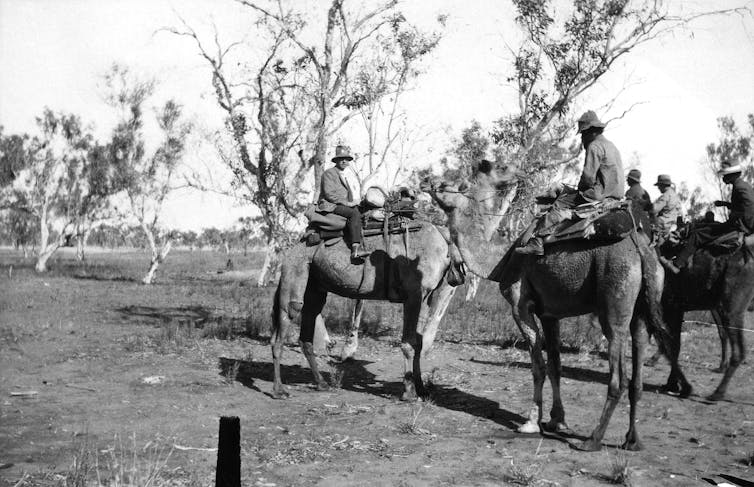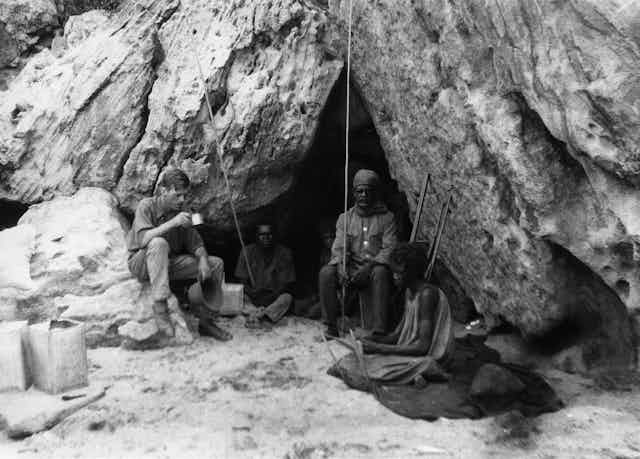Historic hair samples collected from Aboriginal people show that following an initial migration 50,000 years ago, populations spread rapidly around the east and west coasts of Australia.
Our research, published in Nature today, also shows that once settled, Aboriginal groups remained in their discrete geographical regions right up until the arrival of Europeans a few hundred years ago.
So where does the evidence for this rapid migration and long settlement come from?
Early expeditions
In a series of remarkable expeditions that ran from the 1920s to 1960s, scientists travelled widely across the Australian outback. They recorded as much anthropological information as possible about Aboriginal Australians.
They recorded film and audio, drawings, songlines, genealogies and extensive physical measurements under tough outback conditions. This included packing in the equipment on camels for the early trips.

The extensive collections from the Board for Anthropological Expeditions are now curated in the South Australian Museum. They contain the vast majority of the black and white film footage you may have seen of traditional Aboriginal culture, songs, hunting practices and ceremonies.
The metadata collected was voluminous. It now comprises possibly the best anthropological collection of an indigenous people in the world.
Locked in the hair
But perhaps the biggest scientific contributions may yet turn out to be hidden within small locks of hair.
These were collected with permission (such as it was given in the situation and era) for a minor project to study the variation of Aboriginal hair types across Australia.
But the hair clippings turn out to preserve an incredible record of the genetic diversity and distribution of Indigenous Australia prior to European disruption.
Importantly, the detailed genealogical data collected with each sample allows the genetic lineages to be placed on the map back through several generations.
This allowed us to reconstruct the genetic structure within Australia prior to the forced relocation of Aboriginal people to missions and stations, sometimes thousands of kilometres from their traditional lands.
Reconnecting histories
This project was only possible through partnership with Aboriginal families and communities. So we needed to design an ethical framework and protocol for such unprecedented work.
This was based on large amounts of archival research performed by our team members in the Aboriginal Family History Unit of the South Australian Museum, to locate and contact the original donors, or their descendants and family elders.
We arranged a meeting time, and then the combined team spent several days in each Aboriginal community talking to individual families about the project, and passing on copies of the archival material.
We discussed both the potential and pitfalls of genetic research, and answered common questions. These included why the results cannot be used for land claim issues (insufficient geographical resolution) or as a test of Aboriginality (which is a cultural, rather than genetic, association).
The feedback from communities was overwhelmingly positive. There was a strong interest in how a genetic map of Aboriginal Australia could help people of the stolen generation to reconnect with family and country.
It could also help facilitate the repatriation of Aboriginal samples and artefacts held in museums.
The DNA results
The initial genetic results not only reveal exciting insights into the deep genetic history of the continent, but also showcase the enormous potential of our project.
We mapped the maternal genetic lineages onto the birthplace of the oldest recorded maternal ancestor (sometimes two to three generations back) and found there were striking patterns of Australia’s genetic past.
There were many very deep genetic branches, stretching back 45,000 to 50,000 years. We compared these dates to records of the earliest archaeological sites around Australia. We found that the people appear to have arrived in Australia almost exactly 50,000 years ago.
Early migration
Those first Australians entered a landmass we collectively call “Sahul”, where New Guinea was connected to Australia.
The Gulf of Carpentaria was a massive fresh water lake at the time and most likely a very attractive place for the founding population.
The genetic lineages show that the first Aboriginal populations swept around the coasts of Australia in two parallel waves. One went clockwise and the other counter-clockwise, before meeting somewhere in South Australia.
The occupation of the coasts was rapid, perhaps taking no longer than 2,000 to 3,000 years. But after that, the genetic patterns suggest that populations quickly settled down into specific territory or country, and have moved very little since.
The genetic lineages within each region are clearly very divergent. They tell us that people – once settled in a particular landscape – stayed connected within their realms for up to 50,000 years despite huge environmental and climate changes.
We should remember that this is about ten times as long as all of the European history we’re commonly taught.
This pattern is very unusual elsewhere in the world, and underlines why there might be such remarkable Aboriginal cultural and spiritual connection to land and country.
As Kaurna Elder, Lewis O’Brien, one of the original hair donors and part of the advisory group for the study, put it:
Aboriginal people have always known that we have been on our land since the start of our time, but it is important to have science show that to the rest of the world.
There is more information on this work by the Aboriginal History Protect available in this series of videos.

